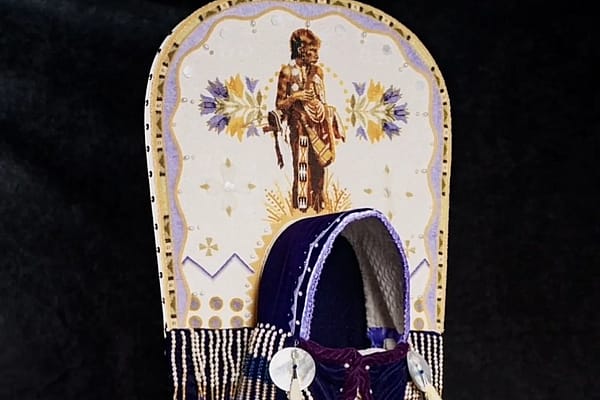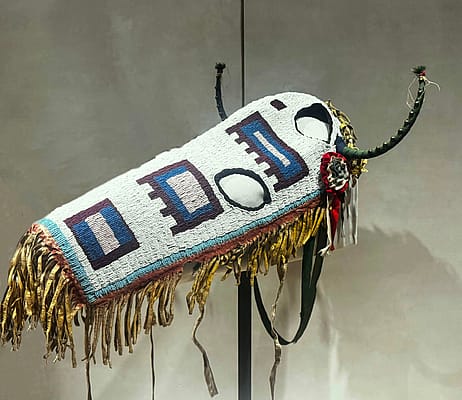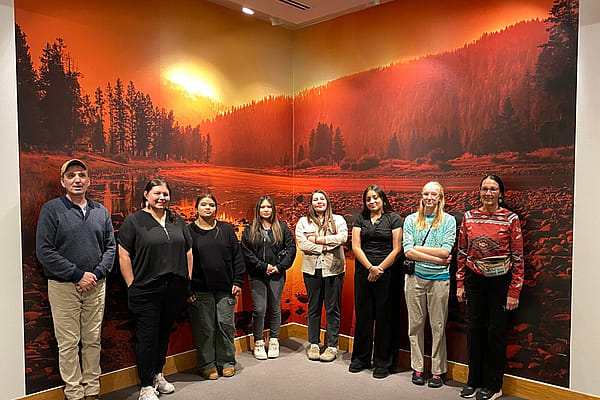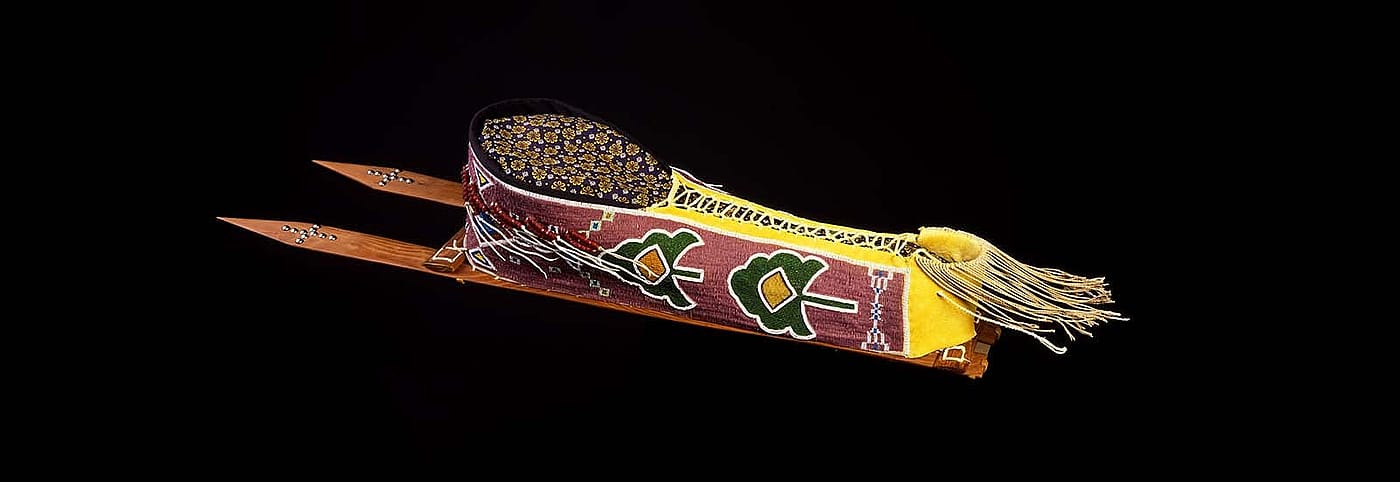
Paukeigope, An Artist of the Southern Plains – Points West Online
Originally published in Points West magazine
Summer 2004
Paukeigope: An Artist of the Southern Plains
By Emma Hansen
Former Curator, Plains Indian Museum
I first met Vanessa Paukeigope Jennings more than twenty years ago while working at the University of Oklahoma on a project to develop an exhibition on the Plains Apache (also known as Kiowa Apache) people of Oklahoma—From Generation to Generation: The Plains Apache Way. The development of this groundbreaking exhibition pioneered a new approach in the museum field that has since become the model for many exhibitions focusing on the arts, histories, and cultures of Native American people. Under this project completed in cooperation with the Apache Tribe of Oklahoma, tribal artists, traditionalists, leaders, scholars, and other community members for the first time were not only the subjects of the exhibition but were actively involved in providing their own perspectives, directions, and inspirations from which exhibition content and design were developed. Most of the works included in the exhibition were actually created by contemporary Plains Apache artists.
A University colleague and I had traveled to Anadarko—a small town in southwestern Oklahoma and the central community for Kiowa, Apache, Caddo, and Wichita people—to locate an artist to make a child’s buckskin dress for the exhibition. After asking tribal elders to recommend artists of traditional clothing, we were directed to the home of Vanessa Morgan (Jennings), a young woman whose grandmother had been a renowned beadworker and a well-respected Plains Apache woman. We were instructed by one elder, “Be sure to tell Vanessa that I sent you.”
The young woman was surprised to see two strangers appear at her door, but she welcomed us into her home, where we spent the afternoon learning about her work in beadwork and other arts, her heritage as a traditional woman learned from her Kiowa and Plains Apache grandparents, and the legacy she hoped to pass on to her own children. She brought out a large trunk that contained a dress made of soft tanned deer hide with simple but elegant beadwork that had been made by her grandmother, Jeanette Berry Mopope; and, she talked abut her childhood with her grandparents filled with traditional teachings, stories, songs, ceremonies, and powwows. By the end of the visit, she had agreed to make the dress for the exhibition.
Paukeigope has since acknowledged that the making of that child’s dress—her first work of art made for a museum—was the beginning of her career as a traditional Southern Plains artist. Since that time she has received numerous national and international awards and recognition of her artistry, exhibited her hide clothing, beaded cradles, and other creations in major North American museums, and sold many examples of her work to discriminating collectors of Native American art. Ironically, like many American Indian artists, Paukeigope did not support herself through sales of her artwork and, for most of her life, she earned her living as an employee of the Bureau of Indian Affairs.
Vanessa Santos (Morgan) Jennings was born on October 5, 1952, in Tempe, Arizona, the daughter of Laquinta Mopope Santos and Clifford Santos. Her father was from the Gila River Pima Reservation and her mother was a young Kiowa and Apache nurse from Oklahoma working for the Indian Health Service in Arizona. Paukeigope was the oldest grandchild of renowned Kiowa painter Stephen Mopope and Plains Apache traditional artist Jeanette Berry Mopope. She credits her grandparents, who brought her from Arizona to live with them on their Oklahoma allotment when she was a year old, for teaching her traditional Kiowa and Apache philosophies, manners, and arts that have guided her throughout her life.
Stephen Mopope was a member of the Kiowa Five, an internationally acclaimed group of artists working at the University of Oklahoma in 1927–1929, and is considered to be one of the most influential Indian artists of the 20th century. Paukeigope, however, remembers him as a traditional man with a wonderful sense of humor and recalls the warmth of the home provided by her grandparents. “I had two really wonderful people in my life and those were my grandparents. My grandfather, up until the end, was a very traditional man. He painted, he was a singer, he played the flute, he did wonderful things with his life. My grandmother was an accomplished singer, she was a beadworker, she was an extraordinary person. And, they were willing to share what they had. I am the product of that compassion and that kindness.”[1]
Paukeigope acknowledges not only her grandparents, but also the generations who went before them for her place in life as an accomplished artist and traditional Kiowa and Apache woman. She is named for her maternal great grandmother Paukeigope (Etta Mopope). She and her mother Keintaddle were well-known Kiowa beadwork artists, singers, storytellers, and makers of cradles. Another great grandmother (the mother of Jeanette Berry Mopope) was Anna E. Jones Berry, who was also a beadworker and cradle maker. Paukeigope describes her life as a part of an ancient continuum built upon the accumulated knowledge and experiences of her familial ancestors that carries into her children and grandchildren’s generations. For this reason, she feels an obligation to pass on to her children and grandchildren the Kiowa and Apache traditions, philosophies, and arts that she learned from her grandparents.
Before beginning to do beadwork in earnest at the age of eleven, Paukeigope sorted beads for her grandmother as she created cradles, dresses, moccasins, leggings, and purses. She said that her grandmother always made wonderful dresses, moccasins, and leggings for her and her younger sister Stevette for the round of powwows and ceremonies the family attended. Her grandmother also made powwow clothing for Kiowa, Apache, and members of other Oklahoma tribes. She recalls that her grandmother had very strict beliefs with regard to colors and designs. She taught her to have respect for family designs and to use only designs that belonged to their family. To copy another family’s design would be disrespectful and dishonest because each design has a life and history of its own. The only time she should use another family’s designs is if they were given to her by a family member such as an elderly beadworker with no daughters or granddaughters who wanted to ensure that a design would be preserved for posterity.[2]
Another important influence in Paukeigope’s life is her participation in the O-Ho-Mah Lodge Society, a Kiowa war dance society with roots deep in tribal history. The long time involvement of her family in O-Ho-Mah Lodge is reflected in the songs of her grandfather Stephen Mopope and his father George Mopope, who continued to support the society during the early reservation period despite threats from Indian agency officials. Their songs are performed at ceremonies each year. Both of her sons, Gabriel and Seth, also have their own songs as active members of O-Ho-Mah Lodge.
Paukeigope’s traditional artwork includes dresses, leggings, cradles, lances, horse equipment, shirts and jackets, dolls, and other objects. She has taught bead working within her own tribal community and traveled nationally and internationally for presentations on her work. In 1989, she was awarded a National Heritage Fellowship from the National Endowment for the Arts in recognition of her mastery of Kiowa traditional arts. Other honors include the President Award from the Red Earth Festival and First Place Awards at the Santa Fe Indian Market. In 1996, she and her work were honored at the Center’s Plains Indian Seminar titled Powerful Expressions: Art of Plains Indian Women with the keynote address delivered by Dr. JoAllyn Archambault of the National Museum of Natural History of the Smithsonian Institution. In this presentation, Dr. Archambault noted “the way Vanessa lives epitomizes the best kinds of values and virtues of Plains Indian women.”[3] In June 2004, she will be recognized at the Oklahoma City Red Earth Festival as the Honored One—the highest award of this annual celebration of Native arts.
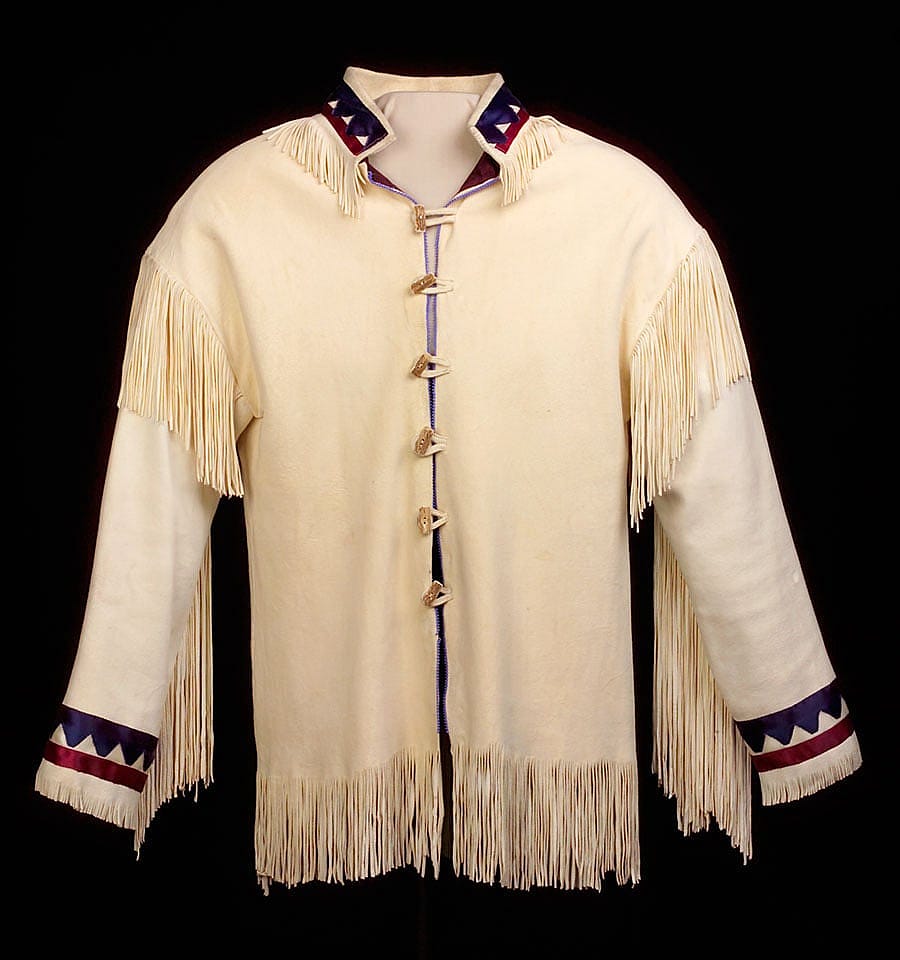
In recent years, Paukeigope has concentrated on making distinctive and highly decorated cradles, many of which are now in private collections and museums, including the Plains Indian Museum. In 2003, she received the highest award in the category of diverse art forms at the Santa Fe Indian Market for a cradle she named “Rez Baby.” The cradle was decorated entirely in pony beads in recognition of the earliest style of Kiowa beadwork. She describes her enjoyment in creating cradles in the following way: “The color, design, and artistry of cradleboards impress me as a celebration of life. These cradleboards are symbols of humanity, honoring our unnamed sisters and grandmothers who rose up against overwhelming odds of war, cultural genocide, death, and other monumental events to celebrate a newborn’s life as only women can: to represent the promise of hope for the future.”[4]
The design of the cradle in the Plains Indian Museum collection is based on a photograph of her grandfather Stephen Mopope as a baby carried in a cradle on the back of his mother Etta Mopope. The cradle, long gone from the family’s possession, had been made by Etta Mopope and her mother Keintaddle. Using the black and white photograph as her guide, Paukeigope decided to make a cradle in the same design in honor of her grandfather. To her surprise the original cradle was identified in the collection of the Taylor Museum, Colorado Springs Fine Arts Center, and she found that the black and white photograph had reversed the values of the light and dark colors. She learned from this experience and noted, “However, the final effect in my finished cradleboard is one that I hope would have made Keintaddle and Jeanette Mopope proud.”[5]
The pink beads in the cradle were given to Paukeigope by Occitan-speaking people of the Provence region of southern France. She met this group of people, united by a desire to maintain their distinctive dialect, on a trip to France in the summer of 1992. Since that trip, strong friendships have developed, and she has made three additional visits to this region. For her next visit, she will be taking a cradle with a beaded design featuring words of the Occitan dialect to be given as a gift. According to Paukeigope, the pink color of the beads reminds her of the subtle pink and purple hues of prairie grasses in Oklahoma as they are moved by the wind.[6]
For many years, Paukeigope has lived on her grandparents’ land where she grew up in an area known as Red Stone near Fort Cobb, Oklahoma. In her home she is surrounded by her grandparents’ belongings—her grandfather’s paintings, his eagle feather bonnet, and his dance clothing, and her grandmother’s dresses, leggings, moccasins, and cradles she had made. In a recent telephone conversation, she reminded me of our first meeting and told me that at the time she felt obligated to make the dress for the exhibition out of respect for the Apache elder who said, “Be sure to tell Vanessa that I sent you.” Every day she is cognizant of her gratitude to her elders and is actively involved in teaching what she learned from her grandparents to the next generations—her children and grandchildren—in keeping with the instructions of her grandmother: “No one lives forever. Pay attention because you are the one who will take my place. You tell your grandchildren that it’s done this way because that’s how my grandmother showed me.”[7]
 Notes:
Notes:
1. Vanessa Paukeigope Jennings in a presentation at Plains Indian Museum Seminar in September 1996.
2. Ibid.
3. JoAllyn Archambault in Kiowa Generations, Plains Indian Museum Seminar, September 1996.
4. Vanessa Paukeigope Jennings, “Why I Make Cradleboards.” Gifts of Pride and Love: Kiowa and Comanche Cradles. Barbara A. Hail, Editor. Haffenrefer Museum of Anthropology, Brown University, 2000, p. 96.
5. Ibid, p. 98. 6. Vanessa Paukeigope Jennings, phone interview, March 11, 2004.
7. Jennings, 2000, p. 95.
Post 176
Written By
Nancy McClure
Nancy now does Grants & Foundations Relations for the Center of the West's Development Department, but was formerly the Content Producer for the Center's Public Relations Department, where her work included writing and updating website content, publicizing events, copy editing, working with images, and producing the e-newsletter Western Wire. Her current job is seeking and applying for funding from government grants and private foundations. In her spare time, Nancy enjoys photography, reading, flower gardening, and playing the flute.
![Vannesa Paukeigope Jennings at the Buffalo Bill [Center of the West], 1996. Photo by Lucille Warters.](https://centerofthewest.org/cdn-cgi/image/width=600,height=890,fit=crop,quality=80,scq=60,gravity=auto,sharpen=1,metadata=none,format=auto,onerror=redirect/wp-content/uploads/2017/10/PW176_PaukeigopeJennings.jpg)




